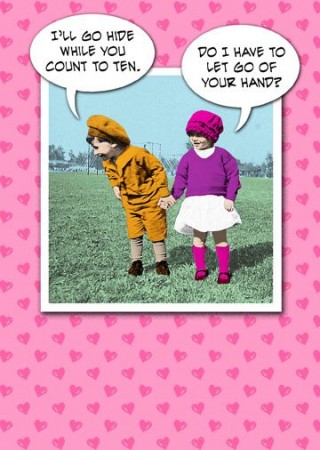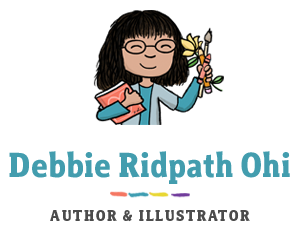
Chuck Ingwersen is a freelance writer and cartoonist who posts his “cartoons, short stories and bad poetry” on his humor blog, Words And Toons.
You can find Chuck’s greeting cards at http://www.zazzle.com/chuckink.
How did you get into greeting card design?
I’ve created funny greeting cards for family members for as long as I can remember, and it’s been my goal for years to become a published greeting card writer and artist. After more than 20 years as a newspaper writer, editor and page designer, I made the leap into the freelance world in 2007, and I’m happy to say I’ve have had some success in the greeting card field.
In 2007, Gallant Greetings started a new line of humor cards, and I submitted dozens of my creations. Gallant bought 16 of my cards from those submissions. Since then, I’ve sold a good number of my cards to Shoebox (Hallmark’s humor line), Oatmeal Studios and It Takes Two.
How do you come up with your ideas? Do you sit down and have brainstorming sessions? Do you carry and notebook and write down ideas as they come?
I’m constantly brainstorming throughout the day, and if I get what I think is a good idea I’ll grab the notebook and jot it down. A notebook next to my bed is a must, since many ideas come just before I fall asleep. I also set aside blocks of time a couple days each week in which I’ll write in a stream-of-consciousness mode, letting ideas flow without much editing. I love going back later to polish those scribblings into fully formed ideas.
What made you decide to sell your own cards?
I was intrigued by the Print On Demand model and where online sales might be headed, so I decided to test the waters. It’s great to have cards online not only for the opportunity to sell them, but to get feedback and to be part of an artists community.
How many cards do you sell a month?
The number of sales varies wildly by month and by season. I had terrific sales from my Zazzle store in November, selling roughly 2,000 cards (plus a good number of other products featuring my artwork). Of course, most of the cards I sold were Christmas cards, and many of those sales were bulk sales. The largest bulk sale was 800. Obviously, Christmas purchases make November the best month for sales, by a wide margin. By comparison, I sold just over 200 cards from my Zazzle store in October.
How much do you make selling cards a month? Or if you’d rather not share that specific info, approx. what percentage of your total income per month comes from the cards that you sell on sites like Zazzle and Greeting Card Universe?
Percentage of total income is fairly small, but the arrow is going up for online sales as I continue to add new designs.

Which site do you prefer: Zazzle or GCU? (and why) What are the pros and cons of using each?
Zazzle has become a clear favorite for me. It offers a wide variety of products to work with, good store customization and promotion tools, the ability to set your commission percentage and a very active community. For creators who focus strictly on cards, GCU is a good option and provides a fair commission structure. I have to say that both Zazzle and GCU do a tremendous job with their printing. The quality of the printed cards is first-rate.
Why don’t you also sell on Cafepress?
I felt like I got lost in the enormity of Cafepress, and didn’t have much success there. I found it less inviting a community than Zazzle. After CP changed its commission structure (to the detriment of artists) not too long ago, I closed my CP store.
How much marketing do you do?
The short answer: Not enough. I do some promotion on my cartoon and humor writing blog (wordsandtoons.com) and my webcomic ( http://captainscratchy.com ), as well as Facebook. Twitter is still on my to-do list.

What advice do you have for beginning card designers?
Besides “do better marketing than me,” here are a few tips:
1) It all starts with creating high-quality content, and that starts with having a passion for the art/writing. Without the passion for the work itself, it can get discouraging when online sales are slow or when the card companies reject your submissions.
2) You’ll really have an edge if you find a niche that isn’t being filled — something that makes you stand out in a crowd. But make sure it’s something you love to do. Don’t try to “play to the market.” Do work that pleases and inspires you, and the joy you put into it will be evident.
3) Hone multiple skills. In my case, my writing skills often give me an edge over people who are better artists than me. Some people are excellent marketers, which might give them an edge over a great designer who is marketing-challenged. Some people get the edge by having superior tech skills. My point is that even if you’re a great designer, learning other skill sets can make a huge difference.
4) Be able to take rejection in stride, and be persistent. I’ve had some success in a relatively short time as a freelancer, but I’ve also had plenty of my submissions rejected by various card companies. That’s a given for a freelancer. The competition is fierce and budgets have gotten tighter. Rejection doesn’t mean your work isn’t good. Rejection just means you have to dust yourself off and prepare to send out the next batch of submissions.
For more insights from book creators, see my Inkygirl Interview Archives and Advice For Young Writers And Illustrators From Book Creators.

